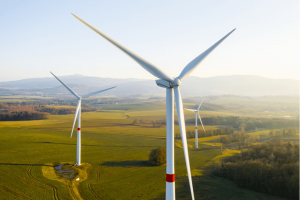
Increase in focus of renewable energy sources
If there is one positive outcome that has resulted from the pandemic, it is that the consumption and emission of greenhouse gases fell significantly due to a shift in the working dynamics . As a result, cities that were previously consumed by pollution saw cleaner skies and breathable air, along with thriving wildlife.
This and energy resilience issues caused by over-reliance on single suppliers has somewhat shifted the focus onto utilising more renewable sources of energy. It is expected that by the end of 2021, global investment in renewable energy will rise to USD1.9 trillion, as companies and governments look to meet climate targets.
The simplest definition of renewable energy is using natural resources that are constantly replenished in order to generate energy/power.
Two of the most notable renewable energy sources are solar energy (using sunlight) and wind energy.
Technological innovation and better understanding of how to harness renewable energies has brought down costs and increased the output of clean energy generated. The best places that wind farms and turbines should be installed would be remote areas that generate high level of winds, with a rise in projects for offshore wind power.
As with each energy source, regardless of it being renewable or nonrenewable, there are advantages and disadvantages associated.
One advantage of wind energy is that it is extremely cost effective in the long term. This is because wind energy systems have low operating expenses as there is no fuel cost to run them.
In USA, wind energy accounts for slightly over 6% of energy generation, and is now slowly becoming the cheapest energy source in many parts of the country.
In recent months, there has been an increase of creation of projects across the US on growing wind farms to produce clean energy. It is expected by 2050 that 600,000 new jobs will be created for the design, manufacture, installation, maintenance and support for wind turbines.
Another major advantage of wind energy is that there is no output of harmful pollutants such as carbon dioxide, nitrogen oxide, sulphur dioxide. This reduces the environmental damage significantly, along with reducing economic problems associated.
International treaty’s such as the Paris Agreement (or Paris Accords) and COP26 climate summit have put pressure on countries around the world to reduce the level of greenhouse emissions, and start moving towards more renewable sources of energy.
G20 countries recently pledged to pursue efforts to limit global warning with meaningful and effective actions by 2050.
One challenge is that it is expensive to set up the wind farm/turbines, as there are heavy upfront investments required. Another challenge in the initial stage is that it could result in the erosion and other potential environmental problems when setting up the wind turbines.
Operating and maintenance (Q&M) costs typically account for between 20% to 25% of the total levelised cost of electricity (LCOE) of current wind power systems, and 11% to 30% of the LCOE in wind projects.
However, over time, these costs have decreased by 2%, through the development of technology to better facilitate the processes, as well as an increase in scientific interest towards failure analysis.
Maxwell GeoSystems has always taken environmental impact into serious consideration on each project. The bespoke MissionOS platform helps clients and projects collect, process and analyse performance data to enhance operational and environmental performance.
The highly configurable data platform is designed for the entire infrastructure life cycle and can manage data from planning through construction and operational maintenance.
MissionOS real time SCADA dash boards, CCTV, sensor predictions models and automation and streamlining of event management processes is enhancing the delivery of sustainable renewable energy.
To learn more about the different capabilities of MissionOS, visit: https://www.maxwellgeosystems.com/benefits/environmental-performance



